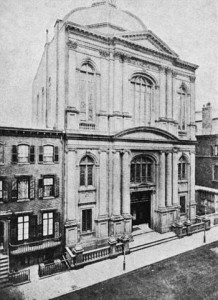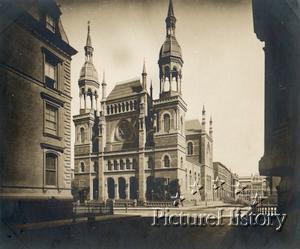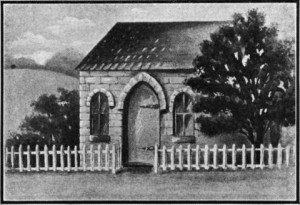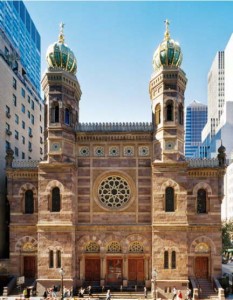A Guided History by Dara Slepoy
Introduction
Illustration of First Mill Street Synagogue, New York, 1730. A very “modest” building that was just the start of synagogues in New York City.
Synagogues in early America were not only religious centers for Jews, but centers for their social and economic lives. Synagogues provided a place of comfort and understanding in a new land foreign to the religion. Synagogues were thus essential to every Jewish community, and that was no exception in New York City. New York city had one of the largest Jewish populations and continuous Jewish immigration. This influx of Jews led to constant expansion and growth of synagogues and the Jewish community as a whole. While Jewish law dictates no guidelines for a synagogue, it is important to acknowledge certain ones that arose over time by the people. New York is unique in that its Jewish community never dwindled, it was constantly growing, leading to a wide array of synagogues in different styles and sizes throughout this early period, including the significant Moorish Revival architecture. I want to analyze the development of synagogues in New York along with social, political and economic context. What did they start off like, what did they become and why.
The time frame chosen ranges from the late seventeen to late eighteen hundreds in New York City, it shows the beginning of synagogue architecture in the United States and captures the main styles that subsequentialy followed the initial settling. The resources chosen reflect the range in time period, and also provide a background into the purpose of synagogues and immigration into the United States. Images are essential primary sources when analyzing architecture, it allows the reader to see the style and feel the impact for themselves, however, nothing can compare to the feeling of seeing some of these grand structures in person. The sources are grouped according to topics, background of Judaism in New York, synagogue background, evolution of synagogues in New York, and finally images.
Background of Judaism in New York City
It is important to have background in Judaism in both American and New York City. How, why and when did they come to America. This will give us a foundation in understanding the purpose of synagogues in American Judaism.
Early American Jewry: The Jews of New York, New England and Canada. 1649-1795 by Jacob Marcus.
This book provides the paper with basic historical context on how and why the first Jews were motivated to immigrate to America. This books helps us understand the American Jews of the colonial and early national period, and realize that the New World was not immediately accepting of Jews as it would later be. He places an emphasis on New Amsterdam, which is where the synagogues would later be built. It provides a general but necessary overview to get the paper started.
A Time for Planting: The First Migration by Eli Faber
Eli Faber’s book on Jews in America specifically touches on the years 1654-1820 and the development of the religion, starting with their immigration to the New World from Europe. The Jews hoped to find tolerance and freedom in America and were able to create a community and cohesion with those around them. With this sense of community they built synagogues, schools, and cemeteries, all while at first, fitting in stylistically to the rest of the colonists. Faber focuses on different communities, including New York.
General Synagogue Background
General synagogue architecture is necessary for understanding what it is and what it is used for. This again will provide a base for understanding synagogues specifically in New York City.
The Synagogue by Brian Breffny
“The synagogue would be their bond, the pivot of their religious life and eventually also of their social life” (20). Breffny states the importance of synagogues and how and why it came to be, since no Jewish law dictates the need for one. Breffny focuses on how synagoguges were a creation of the people and thus influenced its style.
“Synagogue” in Encyclopaedia Judaica by Louis Isaac Rabinowitz
This encyclopedia entry gives an overview of synagogues, their origin, and the main styles categorized by time period. The synagogue lacks any continuity, “its requirements regarding the synagogue were never enough to create a precise architectural program, which spurred the Jews to borrow some elements and solutions from their neighbors.” Jews were given the freedom to create their own house of worship, and this led to the different phases in synagogue architectural style.
American Judaism by Nathan Glazer
Glazer focuses on different waves of Jewish immigration to the United States. Starting with the first Jewish immigrants in 1654, he explains the changes that occurred socially, politically and even religiously as time went on. He explains that Judaism became “Americanized” or distinctly American, English was used exclusively and reform and modernization of the religion was much easier to bring about in American than it was in Europe. Many examples are given to back up these points, such as development of schooling over time. This book will be useful in examining the social context of the Jewish community and the synagogue from the seventeenth to eighteenth centuries.
The Synagogue in America: A Short Story by Marc Raphael
This book gives social context for synagogue development in America starting at the very beginning, “Thus, after more than a century of Jewish life in colonial America, the 1,500 or so Jews present at the birth of the nation proudly announced their religious institutions to the country and were recognized by its new leader” (1). It provides the reader with context for how and why new synagogues came to be built in New York following waves of immigration.
Evolution in New York Synagogue Architecture and Styles
Finally, we must take a look at specific congregations and synagogues in New York City, and the evolution that occurred in style and function. I will follow several congregations and focus on specific synagogues in New York City to get an idea of popular styles. Why were they popular? Why did these changes occur over time?
The Rise of the Jewish Community of New York 1654-1860 by Hyman B. Grinstein.
Book II- The Synagogues of New York. Originally not permitted to establish a synagogue in the United States, Grinstein explains that it was necessary to worship in private homes until it became to large for that, “Under these conditions, Congregation Shearish Israel, the oldest and, for many years, the only Jewish congregation, was founded. Not until 1729 did the Jews of New York build their first synagogue.” (39). The Mill Street Synagogue was the first temple built in New York, and it was this modest building that started synagogue architecture in the United States. This book explains the development of this congregation and other congregations in New York, and provides us with a great deal of social context. New York was a unique place and created an environment that would allow for the religion to grow and for synagogues to change.
Synagogue Architecture in the United States: History and Interpretation by Rachel Wischnitzer
This book provides a detailed overview of synagogues in New York starting from the first Jewish settlement in 1655. The author chronicles the construction of the very first synagogue that was outside of the home, to how “Moorish Style” was carried over to the United States and spread rapidly throughout the country. While the book focuses on synagogues in many cities, it places a certain emphasis on ones in New York, and the evolution that occurred there.
“Moorish Style: Orientalism, the Jews, and Synagogue Architecture” in Jewish Social Studies by Ivan Davidson Kalmar
This article goes into great detail about the origins of Moorish style. Created from Islamic and Spanish style architecture, Moorish borrows many elements such as the minarets, the dome and the use of the horse-shoe shape throughout. This article explains why the Jews chose this style to build new synagogues in, and how it then spread all over Europe and the United States.
“Synagogues for Today’s Jews” in The Synagogue: studies in origins, archaeology, and architecture by Alfred Werner
Werner describes the earliest synagogue in New York, the Mill Street Temple, the later and influential Temple Emanu-el on Fifth Avenue and finally the transition to Moorish Style.
Central Synagogue’s History Page, Temple Emanu-El’s History Page and Congregation Sheartih Israel all give background from the congregations perspective on their history and development.
Images
I will incorporate these images of specific synagogues throughout the paper to provide context for what I am speaking about, time period and style.

Shearith Israel’s Nineteenth Street Synagogue In New York, 1860-1897. The oldest congregation in the United States.

Temple Emanu-El built in Moorish Revival style in 1868.

Temple Emanu-el stands out amongst the other buildings on the street in New York, no longer blending in like previous synagogues.
Working Bibliography
Breffny, Brian de. The Synagogue. New York: Macmillan Publishing Co, 1978.
Faber, Eli. A Time for Planting: The First Migration. Baltimore: The Johns Hopkins University Press, 1992.
First Mill Street Synagogue. August 8, 1730. Congregation Shearith Israel. http://shearithisrael.org/content/first-mill-street-synagogue 11/12/13.
Glazer, Nathan. American Judaism. Chicago: University of Chicago Press, 1972.
Grinstein, Hyman B. The Rise of the Jewish Community of New York: 1654-1860. Philadelphia: Porcupine Press, 1976.
Images of Central Synagogue. http://nyc-architecture.com/UES/UES004.htm 11/13/13.
Image of Shearith Israel’s Nineteenth Street Synagogue. http://shearithisrael.org/19th-street-synagogue
Kalmar, Ivan Davidson. “Moorish Style: Orientalism, the Jews, and Synagogue Architecture” in Jewish Social Studies, New Series, Vol. 7, No. 3. Indiana: Indiana University Press, 20o1
Marcus, Jacob Rader. Early American Jewry: The Jews of New York, New England and Canada. 1649-1795. Philadelphia: The Jewish Publication Society of America, 1951.
“Our History” Central Synagogue. Accessed December 1, 2013 http://www.centralsynagogue.org/about_us/our_history
Rabinowitz, Louis Isaac. “Synagogue” in Encyclopaedia Judaica. Ed. by Michael Berenbaum and Fred Skolnik. Vol. 19. 2nd ed. Detroit: Macmillan Reference USA, 2007.
Raphael, Marc Lee. The Synagogue in America: A Short Story. New York: New York University Press, 2011.
Roth, Cecil. “America.” Encyclopedia Judaica. Ed. Michael Berenbaum and Fred Skolnik. Vol. 2. 2nd ed. Detroit: Macmillan Reference, USA, 2007.
Temple Emanu-El 1868. New York Architecture. http://www.nyc-architecture.com/GON/GON025.htm 11/12/13.
Werner, Alfred. “Synagogues for Today’s Jews” in The Synagogue: studies in origins, archaeology, and architecture. Ed. by Harry M. Orlinsky. New York: Ktav Publishing House, 1975.
Wischnitzer, Rachel. Synagogue Architecture in the United States: History and Interpretation. Philadelphia: The Jewish Publication Society of America, 1955.



